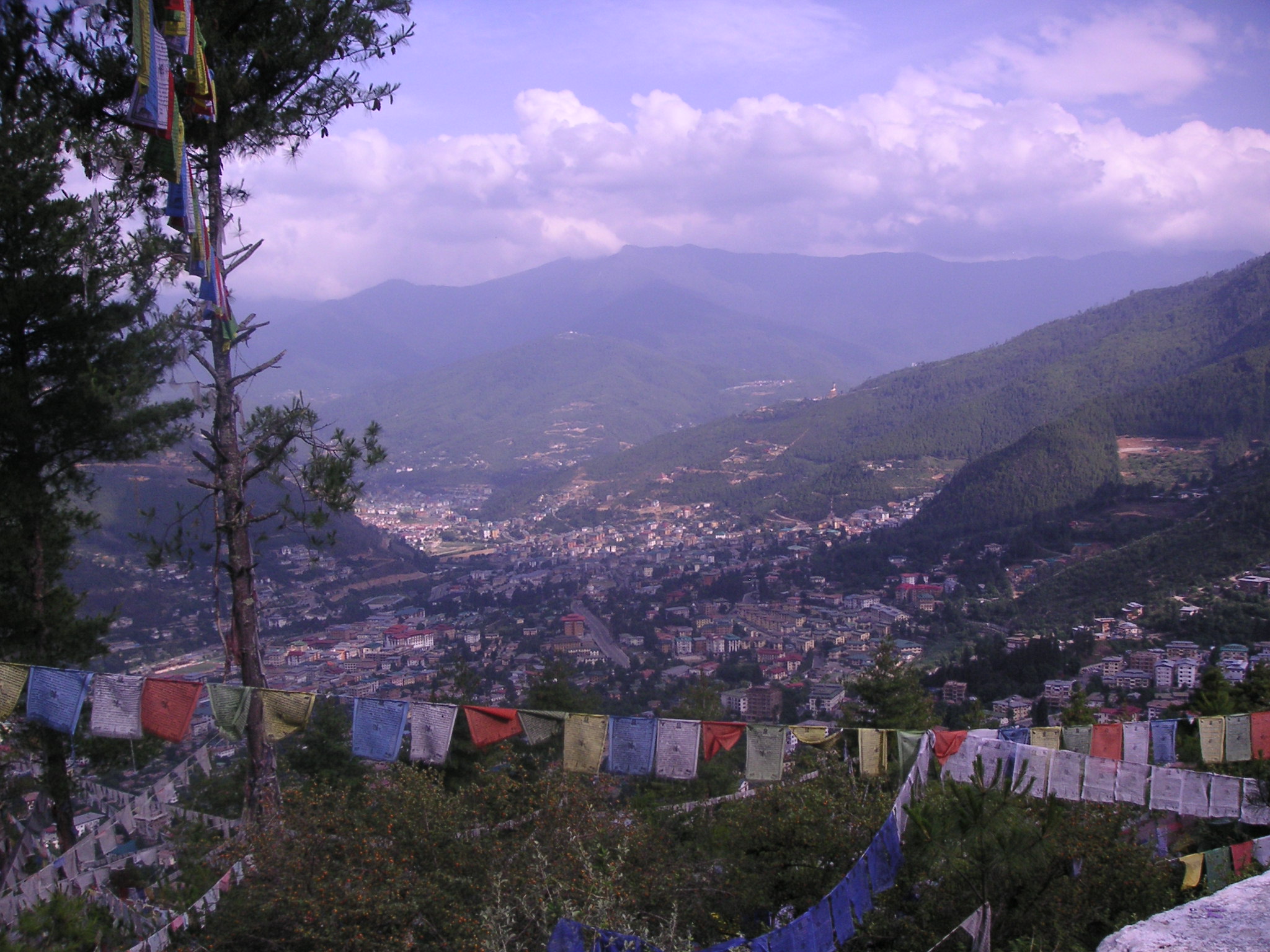
Day 3 – READ Center Visit in Thimphu
By Regula Spottl, DFW Traveler and Member of the NC, Greensboro-5 chapter
Another sunny and warm day: unexpected but very welcome!
As usual, breakfast buffet at the hotel between 7 and 9 am. Beth Ellen, Dining for Women President, introduced the grant DFW gave READ Bhutan in 2017.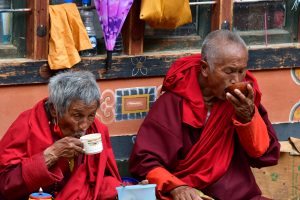
Next, we went to the Institute of Traditional Medicine. This was not on the itinerary but I had told our guide about it on the first day. A small museum with interesting illustrations on large posters and samples of 300 herbs, some minerals, and animal products used in natural remedies. I had read about it in Treasures of the Thunder Dragon: A Portrait of Bhutan by Ashi Dori Wangmo Wangchuck (the queen mother). I highly recommend this book.
Bhutan’s traditional medicine is most closely related to Tibetan medicine and is a mixture of Ayurveda and Chinese medicine. “The Institute provides medical services, trains traditional doctors, and conducts research on Bhutan’s medicinal plants to identify the ingredients in centuries-old remedies and help develop new health products.” Details….
The next step was the School of Traditional Arts and Crafts (Facebook page) where students are trained in Bhutan’s traditional 13 arts and crafts.
Slogan on the main building:
GET SKILLED, BE SOMEBODY
BE USEFUL TO YOURSELF
BE USEFUL TO PARENTS
BE USEFUL TO COMMUNITY
BE USEFUL TO TSA-WA-SUN (king, kingdom, and government)
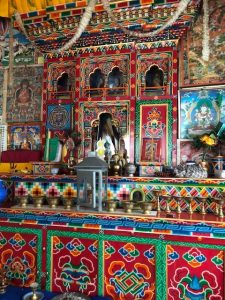 On a wall near the entrance are posted the Five Zoric Commitments: Commitment to quality, to life-long learning, to enterprise, to dignity of labor, and integrity. Definitely something from which we can learn!
On a wall near the entrance are posted the Five Zoric Commitments: Commitment to quality, to life-long learning, to enterprise, to dignity of labor, and integrity. Definitely something from which we can learn!
The shop where the students’ products are sold accepted credit cards, so some of us did some heavy shopping. The jacket Gretchen (Bloom) bought is a knock- out! I bought a stunning bead bracelet for 390 Ngultrum (about $6).
For just 20 minutes, we stopped at an archery practice site in the stadium. Archery is Bhutan’s national sport. The bows are hugely sophisticated. Archers must wear traditional costume to play. Video of match with ceremony and decorum… (1.24 mins)
Off to lunch and a formal presentation of the READ grant. Lunch consisted of a bowl of mushroom soup, three large squares of tofu biscuits, a potato pancake, and some vegetables, followed by vanilla ice cream. Delicious!
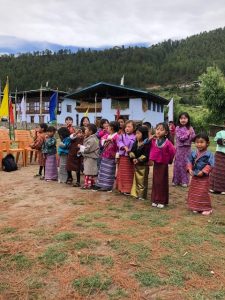 At the visit to the READ center, the ladies welcomed us with a traditional dance and then introduced us to the center activities: hugely impressive.
At the visit to the READ center, the ladies welcomed us with a traditional dance and then introduced us to the center activities: hugely impressive.
About illiteracy: Education up to grade 12 is free, but percentage points in a performance test determine whether a student can continue in the next class. If the student falls below the minimum percentage point, he/she must attend a private school, and parents must pay for it. Many parents cannot afford it, so the education is over, especially for girls. As a next step, some girls marry at the age of 15 to support the family. She and her husband move in with her parents. They start having babies and are more or less stuck in the house. The guys don’t earn enough, but also don’t want their wives to work from home. These young ladies first encounter resistance when they want to go to the READ center, but they manage to go when their husbands are at work and the children are at school. They learn literacy and also financial literacy, for example, to appreciate what they produce, even if it is not much, save the proceeds and expand the business. They become the CFO in the family and gradually receive the respect and support of their husbands. Just learning to fill out the form and apply for a bank account is for many a hurdle. The confidence and competence they gain is immeasurable.
In the READ centers, they also learn craft skills such as felting and basket weaving. They sell these products at markets, special events, and on the Internet, and use the funds for new projects. They have also written and illustrated children’s books for sale. I bought four.
There are nine READ centers throughout Bhutan which all have libraries. This is important because there is only one state library in Thimphu.
For a couple of hours, we talked to the women about their lives and challenges while participating in basket weaving and felting; all this accompanied by drinking milk tea and eating biscuits. It’s an example of a grant that was more than worth it.
Before dinner in town, we had some time to nap, shop, and reflect. I headed to the Swiss Bakery that Lonely Planet lists as a MUST GO for a good coffee. Walking past lots of small shops with shoes, clothing, nick knacks, and a store for monks’ and nuns’ clothing etc., I found a pharmacy that sells cordyceps tea. I had learned about it at the Institute of Traditional Medicine. Cordyceps is a caterpillar that has been mummified by a fungus. It is found in the high mountain regions of Bhutan and used as a remedy for a wide range of health issues. Details on product, benefits and price…
The bakery was closed for renovation, but I found another coffee shop nearby where, over a delicious espresso, I spent time reflecting on the experiences of the day.
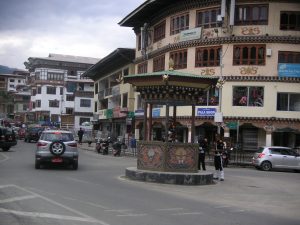 Of course, I had to take photos of a police officer directing traffic in Thimphu. This is the story in “Bhutan’s dark sense of humor” from the BBC: “The capital Thimphu was home to Bhutan’s sole traffic light – for just 24 hours. It was quickly removed to be replaced by a now famous policeman who directs traffic with flamboyant, white-gloved hand movements from the middle of what is one of the city’s busiest streets.” Yes, very flamboyant and theatrical! Video…
Of course, I had to take photos of a police officer directing traffic in Thimphu. This is the story in “Bhutan’s dark sense of humor” from the BBC: “The capital Thimphu was home to Bhutan’s sole traffic light – for just 24 hours. It was quickly removed to be replaced by a now famous policeman who directs traffic with flamboyant, white-gloved hand movements from the middle of what is one of the city’s busiest streets.” Yes, very flamboyant and theatrical! Video…
What an eventful, educational, inspirational and enjoyable day for us to experience together!
